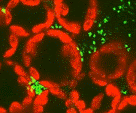Plant Pathology, Department of

Department of Plant Pathology: Faculty Publications
Document Type
Article
Date of this Version
8-2010
Citation
Nat Struct Mol Biol. 2010 August ; 17(8): 997–1003. doi:10.1038/nsmb.1866.
Abstract
RNA interference pathways may involve amplification of secondary siRNAs by RNA-dependent RNA polymerases. In plants, RDR6-dependent secondary siRNAs arise from transcripts targeted by some microRNA (miRNA). Here, Arabidopsis thaliana secondary siRNA from mRNA, and trans-acting siRNA, are shown to be triggered through initial targeting by 22 nt miRNA that associate with AGO1. In contrast to canonical 21 nt miRNA, 22 nt miRNA primarily arise from foldback precursors containing asymmetric bulges. Using artificial miRNA constructs, conversion of asymmetric foldbacks to symmetric foldbacks resulted in production of 21 nt forms of miR173, miR472 and miR828. Both 21 and 22 nt forms associated with AGO1 and guided accurate slicer activity, but only 22 nt miRNA were competent to trigger RDR6-dependent siRNA from target RNA. These data suggest that AGO1 functions differentially with 21 and 22 nt miRNA to engage the RDR6-associated amplification apparatus.


Comments
Copyright 2010. Used by permission.